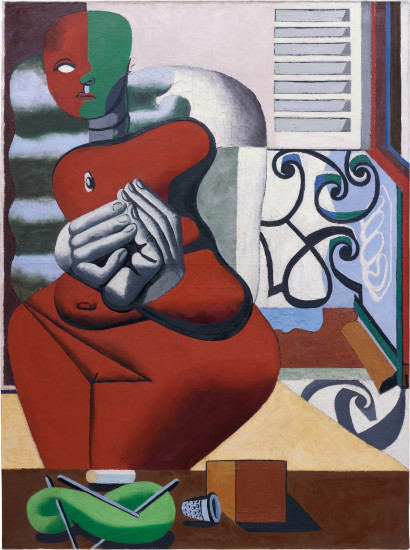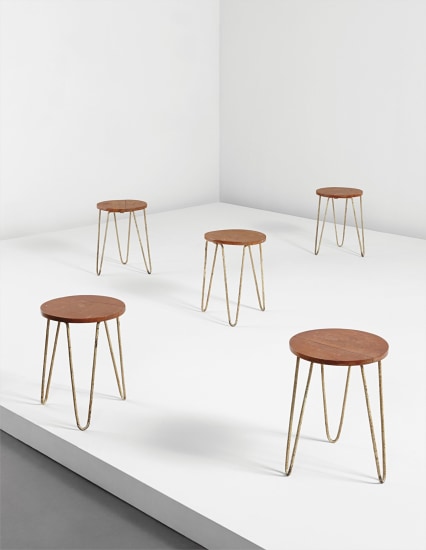Le Corbusier “Solar Day” bas-relief, from the Capital Complex Building, Chandigarh, India ca. 1950 Carved plywood. 20 1/2 x 37 3/8 x 1 in. (52.1 x 94.9 x 2.5 cm.) Reverse-incised with “L. C” and “24.
Provenance Capital Complex Building, Chandigarh, India Catalogue Essay CHANDIGARH: MODEL OF MODERNISM During the Partition of India in 1947, Punjab lost Lahore, its capital, to Pakistan. In his haste to quit the heat, Border Commissions chair Sir Cyril Radcliffe had drawn a reckless line through towns, fields, even houses. In the Punjab alone, ten million Muslims, Hindus, and Sikhs were displaced. Radcliffe had never been to India before and only stayed five weeks. Addressing the urgent need for a Punjabi capital, Prime Minister Nehru commissioned the planning and construction of Chandigarh, a model city to be built in the foothills of the Himalayas. Named for the Hindu goddess Chandi (bearer of lotus and lightning), Chandigarh would function as the symbol of a progressive and auspicious Indian future. American planner Albert Mayer and Polish architect Matthew Nowicki drafted the first drawings of the city, a rectangular grid of ‘superblocks’ intended to house 500,000 residents. Nowicki died in a plane crash in 1950, and Mayer withdrew from the project. In their stead, Le Corbusier and his cousin Pierre Jeanneret undertook the design and completion of the capital complex, including ‘sectors’ for housing, government offices, industry, and commerce. Jeanneret became chief architect after Le Corbusier’s own departure in 1959. Aided by admiring Indian colleagues, Jeanneret built a series of residential and civic buildings including the dramatic Ghandi Bhawan, the library of Ghandian studies at Punjab University. Its canted roofs, like wings, expressed the lofty aspirations of the project. For Jeanneret, no detail was too small; he designed lampposts, manhole covers, paddle boats—everything. Out of necessity, and with respect for his surroundings, he employed local craftsmen to build with local materials. Unlike Sir Radcliffe’s recess, Jeanneret’s fifteen year stay in India was a lifetime. Architectural critic Patwant Singh wrote: “His solutions were not impatient impositions.” Jeanneret helped build by hand what Radcliffe’s arbitrary sweep could not: a modern India. When Jeanneret returned to Europe in 1965, ill and unable to work, he reportedly lamented, “I am leaving my home and going to a foreign country.” His ashes, returned to Chandigarh, were scattered on Lake Sukhna. Read More
Le Corbusier “Solar Day” bas-relief, from the Capital Complex Building, Chandigarh, India ca. 1950 Carved plywood. 20 1/2 x 37 3/8 x 1 in. (52.1 x 94.9 x 2.5 cm.) Reverse-incised with “L. C” and “24.
Provenance Capital Complex Building, Chandigarh, India Catalogue Essay CHANDIGARH: MODEL OF MODERNISM During the Partition of India in 1947, Punjab lost Lahore, its capital, to Pakistan. In his haste to quit the heat, Border Commissions chair Sir Cyril Radcliffe had drawn a reckless line through towns, fields, even houses. In the Punjab alone, ten million Muslims, Hindus, and Sikhs were displaced. Radcliffe had never been to India before and only stayed five weeks. Addressing the urgent need for a Punjabi capital, Prime Minister Nehru commissioned the planning and construction of Chandigarh, a model city to be built in the foothills of the Himalayas. Named for the Hindu goddess Chandi (bearer of lotus and lightning), Chandigarh would function as the symbol of a progressive and auspicious Indian future. American planner Albert Mayer and Polish architect Matthew Nowicki drafted the first drawings of the city, a rectangular grid of ‘superblocks’ intended to house 500,000 residents. Nowicki died in a plane crash in 1950, and Mayer withdrew from the project. In their stead, Le Corbusier and his cousin Pierre Jeanneret undertook the design and completion of the capital complex, including ‘sectors’ for housing, government offices, industry, and commerce. Jeanneret became chief architect after Le Corbusier’s own departure in 1959. Aided by admiring Indian colleagues, Jeanneret built a series of residential and civic buildings including the dramatic Ghandi Bhawan, the library of Ghandian studies at Punjab University. Its canted roofs, like wings, expressed the lofty aspirations of the project. For Jeanneret, no detail was too small; he designed lampposts, manhole covers, paddle boats—everything. Out of necessity, and with respect for his surroundings, he employed local craftsmen to build with local materials. Unlike Sir Radcliffe’s recess, Jeanneret’s fifteen year stay in India was a lifetime. Architectural critic Patwant Singh wrote: “His solutions were not impatient impositions.” Jeanneret helped build by hand what Radcliffe’s arbitrary sweep could not: a modern India. When Jeanneret returned to Europe in 1965, ill and unable to work, he reportedly lamented, “I am leaving my home and going to a foreign country.” His ashes, returned to Chandigarh, were scattered on Lake Sukhna. Read More














Testen Sie LotSearch und seine Premium-Features 7 Tage - ohne Kosten!
Lassen Sie sich automatisch über neue Objekte in kommenden Auktionen benachrichtigen.
Suchauftrag anlegen